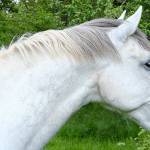Frozen Fecal Transplants in Horses: Four Findings

Following intensive research on the intestinal microbiome over the past several years, researchers now know that the collection of bacteria, protozoa, fungi, metabolic products, and genetic material that make up the microbiome play integral roles in horse health. For example, the intestinal microbiome modulates the immune system, resists pathogens, affects the gut-brain axis, and supports endocrine function. In the case of dysbiosis, or an imbalance in the microbiome, veterinarians may recommend fecal microbiota transplant (FMT).
“Fecal microbiota transplant involves creating a liquid suspension of feces from a healthy donor horse with the hopes of re-establishing a healthy intestinal microbiota in the recipient horse,” explained Ashley Fowler, Ph.D., a nutritionist for Kentucky Equine Research.
In humans, the benefits of FMT were demonstrated in cases of Clostridiodes difficile infection and inflammatory bowel disease. In horses, however, only a few research studies describing FMT have been published, with variable results.
Typically, fresh slurries of feces are used for FMT in horses.
“For practical reasons, when a healthy donor horse is unavailable, being able to use a previously frozen fecal slurry for FMT would be advantageous. The stability of a frozen FMT product in horses has not been studied until now,” Fowler said.
Long and coworkers evaluated the effect of freezing fecal slurries at -20° C or -80° C either in saline or in saline plus glycerol.* Glycerol is a cryoprotectant that preserves organisms and tissues by lowering the freezing point of water and preventing damage to cells.
Fresh fecal samples were collected transrectally from three donor mares that were housed and fed similarly. Samples were immediately transferred to a laboratory to create slurries that were then frozen in either saline or saline plus glycerol for 30, 60, or 90 days. After thawing, bacterial DNA determined the types and amounts of bacteria present in the fecal samples.
“Because DNA measures both live and dead bacteria, cDNA was also measured, which represents the metabolic activity of the presumably live bacteria,” Fowler described.
There were four key findings:
- The largest variations in fecal microbiota identified in this study were between the individual donor horses, not the storage conditions. Regardless, the most dominant types of bacteria were Firmicutes and Bacteroidetes based on both DNA and cDNA analysis, consistent with many previous reports.
- The cDNA of Bacteroidetes was almost half their DNA population, which indicates that only half of the total population of Bacteroidetes was potentially metabolically active. Further, the DNA analysis of certain bacteria was greater than cDNA , suggesting that some bacteria may have an increased contribution to the metabolic footprint despite their lower gene copy number.
- Length of storage significantly affected bacterial community profiles, both increasing and decreasing DNA levels. Samples frozen in saline plus glycerol had less fluctuations compared to samples frozen in saline alone.
- cDNA was less affected by the different storage conditions.
“In sum, cDNA analysis appears useful in measuring metabolic activity of fecal samples rather than simply performing DNA analysis that cannot differentiate between live and dead bacteria. Further, while freezing and storage conditions affect the fecal samples, individual horse variation was a larger factor in sample variability. However, glycerol appears protective when freezing bacteria,” Fowler summarized.
While this important work with FMTs is ongoing, equine nutritionists like Fowler recommend a digestive buffer to help stabilize your horse’s intestinal microbiome, especially during times of stress or when changing any aspect of your horse’s diet.
“Stabilizing the hindgut pH through the use of a time-released hindgut buffer, such as EquiShure, helps provide an environment more suitable for the beneficial microbes. An acidic hindgut pH can create an environment where less desirable microbes proliferate, increasing the risk for microbial dysbiosis,” Fowler advised.
*Long, A.E., D. Pitta, M. Hennessy, N. Indugu, B. Vecchiarelli, D. Luethy, H. Aceto, and S. Hurcombe. 2024. Assessment of fecal bacterial viability and diversity in fresh and frozen fecal microbiota transplant (FMT) product in horses. BMC Veterinary Research 20(1):306.








